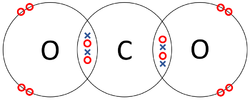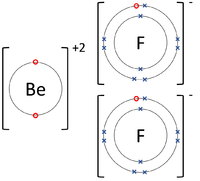Difference between revisions of "Dot and Cross Diagram"
| Line 30: | Line 30: | ||
| style="height:20px; width:200px; text-align:center;" |The [[Beryllium]] [[atom]] donates two [[electron]]s from its [[Outer Shell|outer shell]] to the [[Outer Shell|outer shells]] of each [[Fluorine]] [[atom]]. | | style="height:20px; width:200px; text-align:center;" |The [[Beryllium]] [[atom]] donates two [[electron]]s from its [[Outer Shell|outer shell]] to the [[Outer Shell|outer shells]] of each [[Fluorine]] [[atom]]. | ||
|} | |} | ||
| + | |||
| + | |||
| + | ===References=== | ||
| + | ====AQA==== | ||
| + | |||
| + | :[https://www.amazon.co.uk/gp/product/0008158762/ref=as_li_tl?ie=UTF8&camp=1634&creative=6738&creativeASIN=0008158762&linkCode=as2&tag=nrjc-21&linkId=a0fffa35b3ea49a63404f6704e0df7cc ''Dot and cross diagram, pages 43, 60-1, 64-5, 133-5, GCSE Chemistry; Student Book, Collins, AQA ''] | ||
| + | :[https://www.amazon.co.uk/gp/product/1782945598/ref=as_li_tl?ie=UTF8&camp=1634&creative=6738&creativeASIN=1782945598&linkCode=as2&tag=nrjc-21&linkId=ad276ad49df77ab4b40ab4fd0fe09861 ''Dot and cross diagrams, pages 114, 116, 117, GCSE Combined Science; The Revision Guide, CGP, AQA ''] | ||
| + | :[https://www.amazon.co.uk/gp/product/1782945571/ref=as_li_tl?ie=UTF8&camp=1634&creative=6738&creativeASIN=1782945571&linkCode=as2&tag=nrjc-21&linkId=9e29fad914244909903e5e93f8a01d106 ''Dot and cross diagrams, pages 29, 31, 32, GCSE Chemistry; The Revision Guide, CGP, AQA ''] | ||
| + | :[https://www.amazon.co.uk/gp/product/0198359381/ref=as_li_tl?ie=UTF8&camp=1634&creative=6738&creativeASIN=0198359381&linkCode=as2&tag=nrjc-21&linkId=47c8d1ae58d8b3a5e2094cd447154558 ''Dot and cross diagrams, pages 39, 44-45, GCSE Chemistry; Third Edition, Oxford University Press, AQA ''] | ||
| + | :[https://www.amazon.co.uk/gp/product/178294639X/ref=as_li_tl?ie=UTF8&camp=1634&creative=6738&creativeASIN=178294639X&linkCode=as2&tag=nrjc-21&linkId=51599bb45a2bfaf7c1b6a978b2ca2616 ''Dot and cross diagrams, pages 72-76, 78, 79, 81-83, GCSE Combined Science Trilogy; Chemistry, CGP, AQA ''] | ||
| + | :[https://www.amazon.co.uk/gp/product/1782945962/ref=as_li_tl?ie=UTF8&camp=1634&creative=6738&creativeASIN=1782945962&linkCode=as2&tag=nrjc-21&linkId=476bb5c8d1dfb5c08ac81b6d4d1c98d8 ''Dot and cross diagrams, pages 74-78, 80, 81, 83-85, GCSE Chemistry, CGP, AQA ''] | ||
Revision as of 09:44, 4 November 2019
Contents
Key Stage 4
Meaning
A dot and cross diagram is a diagram used to show how electrons from the outer shells of atoms are shared or transferred in a chemical bond.
About Dot and Cross Diagrams
- Dot and cross diagrams can be used to represent covalent bonds and ionic bonds.
Examples
| The two Oxygen atoms each share two of their electrons with one another. | The two Nitrogen atoms each share three of their electrons with one another. | Each Oxygen shares two of its electrons with the Carbon atom while the Carbon atom shares two electrons with each Oxygen atom. |
| The Lithium atom donates an electron from its outer shell to the outer shell of the Fluorine atom. | The Magnesium atom donates two electrons from its outer shell to the outer shell of the Oxygen atom. | The Beryllium atom donates two electrons from its outer shell to the outer shells of each Fluorine atom. |
References
AQA
- Dot and cross diagram, pages 43, 60-1, 64-5, 133-5, GCSE Chemistry; Student Book, Collins, AQA
- Dot and cross diagrams, pages 114, 116, 117, GCSE Combined Science; The Revision Guide, CGP, AQA
- Dot and cross diagrams, pages 29, 31, 32, GCSE Chemistry; The Revision Guide, CGP, AQA
- Dot and cross diagrams, pages 39, 44-45, GCSE Chemistry; Third Edition, Oxford University Press, AQA
- Dot and cross diagrams, pages 72-76, 78, 79, 81-83, GCSE Combined Science Trilogy; Chemistry, CGP, AQA
- Dot and cross diagrams, pages 74-78, 80, 81, 83-85, GCSE Chemistry, CGP, AQA





